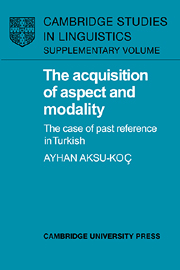Book contents
- Frontmatter
- Contents
- List of figures
- List of tables
- Acknowledgements
- Symbols and abbreviations
- PART I TENSE, ASPECT AND MODALITY IN ACQUISITION
- PART II DEVELOPMENT OF PAST REFERENCE IN TURKISH: FROM ‘PERFECT’ ASPECT TO ‘EVIDENTIAL’ MODALITY
- 4 The empirical study: rationale and hypotheses
- 5 Longitudinal study of early inflectional development
- 6 Experimental study of the production of the pasts of direct vs. indirect experience
- 7 Experimental study of the comprehension and metalinguistic awareness of the pasts of direct vs. indirect experience
- 8 Production and comprehension of the quotative function
- PART III CONCLUSIONS AND GENERAL IMPLICATIONS
- Appendix A
- Notes
- Bibliography
- Subject index
- Name index
8 - Production and comprehension of the quotative function
Published online by Cambridge University Press: 23 September 2009
- Frontmatter
- Contents
- List of figures
- List of tables
- Acknowledgements
- Symbols and abbreviations
- PART I TENSE, ASPECT AND MODALITY IN ACQUISITION
- PART II DEVELOPMENT OF PAST REFERENCE IN TURKISH: FROM ‘PERFECT’ ASPECT TO ‘EVIDENTIAL’ MODALITY
- 4 The empirical study: rationale and hypotheses
- 5 Longitudinal study of early inflectional development
- 6 Experimental study of the production of the pasts of direct vs. indirect experience
- 7 Experimental study of the comprehension and metalinguistic awareness of the pasts of direct vs. indirect experience
- 8 Production and comprehension of the quotative function
- PART III CONCLUSIONS AND GENERAL IMPLICATIONS
- Appendix A
- Notes
- Bibliography
- Subject index
- Name index
Summary
The quotative or hearsay use, it was hypothesized, would be the last grammatical function of the -mlş particle to be discovered by children. In this purely modal function -mlş, indicates that the propositional content of the speaker's utterance is not derived from direct experience but from the ‘spoken word’. In other words, the quotative use of the -mlş, particle involves referring to aspects of discourse itself.
My prediction that the quotative function of -mlş, would be more complex was grounded on both cognitive and semantic considerations. Cognitively, this use would depend on children's ability to talk about events not personally experienced, i.e. on their ability to reconstruct from memory information obtained solely through the medium of language. Since no phase of the event is directly experienced, there will be no cues available from the nonlinguistic context at the time of encoding. Mental representation of such information can be assumed to be more complex just on the basis of processing factors. Furthermore it has been variously noted that young children show reluctance in talking about events not related to the present context, and in particular, about experiences not shared with their interlocutor (Sachs, 1979; de Lemos and Bybee, 1981). These findings suggest that it would be even more difficult for children to report experiences that they have not experienced themselves.
Semantically, I argue that the purely modal use of -mlş rests on a more complex presuppositional structure which is represented at the performative level.
Information
- Type
- Chapter
- Information
- The Acquisition of Aspect and ModalityThe Case of Past Reference in Turkish, pp. 159 - 170Publisher: Cambridge University PressPrint publication year: 1988
